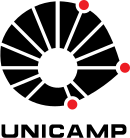
Back جامعة محافظة كامبيناس Arabic Universitat Estatal de Campinas Catalan State University of Campinas CEB Universidade Estadual de Campinas German Ŝtata Universitato de Campinas Esperanto Universidad Estadual de Campinas Spanish Campinase ülikool Estonian دانشگاه کمپیناس Persian Université d'État de Campinas French Università statale di Campinas Italian
Universidade Estadual de Campinas | |
 Logo of the University of Campinas | |
Other name | Unicamp |
|---|---|
| Type | Public research university |
| Established | December 28, 1962[1] |
| Founder | Zeferino Vaz |
| Affiliation | Washington University in St. Louis McDonnell International Scholars Academy[2] |
| Budget | R$2.954 billion[3] |
| Rector | Tom Zé[4] |
Academic staff | 1,795[5] |
Administrative staff | 8,527[5] |
| Students | 34,616[5] |
| Undergraduates | 18,698[5] |
| Postgraduates | 15,918[5] |
| Location | , , Brazil 22°49′02″S 47°04′10″W / 22.81722°S 47.06944°W |
| Campus | Suburban |
| Language | Portuguese |
| Colors | Red & Black [6] |
| Website | www.unicamp.br |
The State University of Campinas (Portuguese: Universidade Estadual de Campinas), commonly called Unicamp, is a public research university in the state of São Paulo, Brazil.
Established in 1962, Unicamp was designed from scratch as an integrated research center unlike other top Brazilian universities, usually created by the consolidation of previously existing schools and institutes.[7][8] Its research focus reflects on almost half[1] of its students being graduate students, the largest proportion across all large universities in Brazil, and also in the large number of graduate programs it offers: 153 compared to 70 undergraduate programs.[5] It also offers several non-degree granting open-enrollment courses to around 8,000 students through its extension school.[9]
Its main campus occupies 3.5 square kilometres (860 acres) located in the district of Barão Geraldo, a suburban area 12 kilometres (7.5 mi) from the downtown center of Campinas, built shortly after the creation of the university. It also has satellite campuses in Limeira, Piracicaba and Paulínia, and manages two technical high schools located in Campinas and Limeira.[10] Funding is provided almost entirely by the state government and, like other Brazilian public universities, no tuition fees or administrative fees are charged for undergraduate and graduate programs.[11]
Unicamp is responsible for around 15% of Brazilian research,[12] a disproportionately high number when compared to much larger and older institutions in the country such as the University of São Paulo.[1] It also produces more patents than any other research organization in Brazil, being second only to the state-owned oil company, Petrobras.[13]
- ^ a b c "Criação da Unicamp".
- ^ "McDonnell International Scholars Academy".
- ^ "2016 Budget Proposal" (PDF). AEPlan. Unicamp. Retrieved 12 January 2016.
- ^ Mateus, Felipe; Coll, Liana (2021-04-19). "Tom Zé toma posse como novo reitor da Unicamp". Unicamp. Retrieved 2021-12-10.
- ^ a b c d e f "A UNICAMP – Números da UNICAMP 2014". Retrieved 1 October 2015.
- ^ "CÓDIGO DE IDENTIDADE VISUAL". Unicamp. Retrieved 19 January 2016.
- ^ Hardy, Cynthia; Fachin, Roberto Costa (1990). Managing Strategy in Academic Institutions: Learning from Brazil. Walter de Gruyter. p. 102. ISBN 3-11-012156-5.
- ^ Markusen, Ann (1999). Second Tier Cities: Rapid Growth Beyond the Metropolis. U of Minnesota Press. pp. 106, 107. ISBN 0-8166-3373-8.
- ^ "EXTECAMP – Escola de Extensão da UNICAMP – (19) 3521-4646 ou 3521-4647". www.extecamp.unicamp.br. Retrieved 2016-01-20.
- ^ Cite error: The named reference
historiawas invoked but never defined (see the help page). - ^ ASCOM. "Foreign Student Guide | UNICAMP – Universidade Estadual de Campinas". www.unicamp.br. Retrieved 2016-01-22.
- ^ "Unicamp é a universidade com mais cursos bem avaliados, segundo MEC". Campinas e Região (in Brazilian Portuguese). 2015-12-27. Retrieved 2016-02-04.
- ^ "The 2015 CWUR World University Rankings are out now". cwur.org. Retrieved 2016-01-19.
© MMXXIII Rich X Search. We shall prevail. All rights reserved. Rich X Search